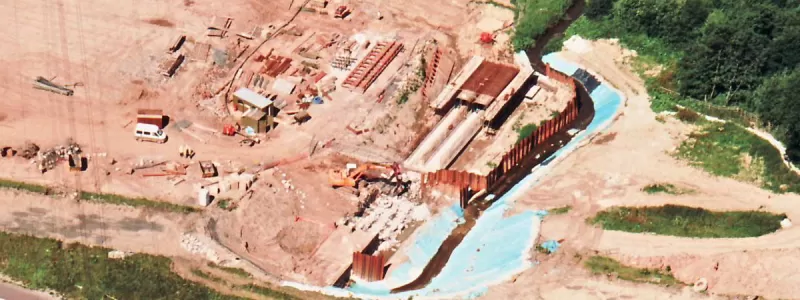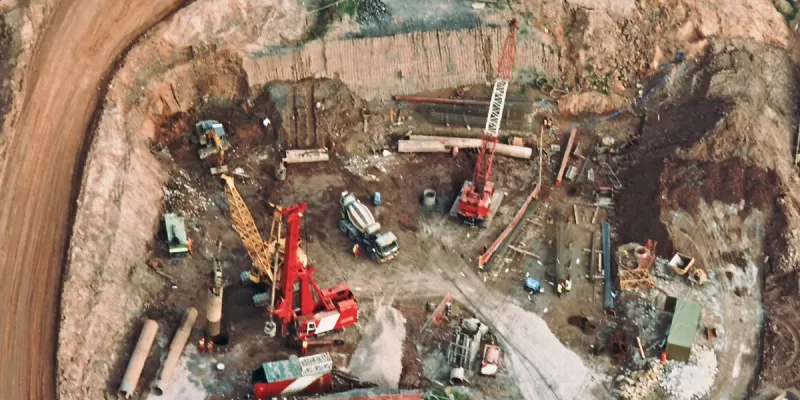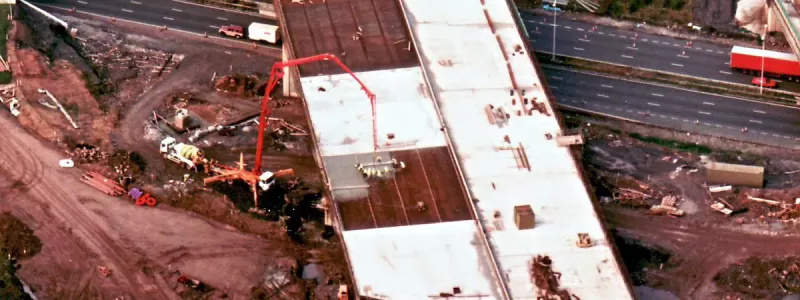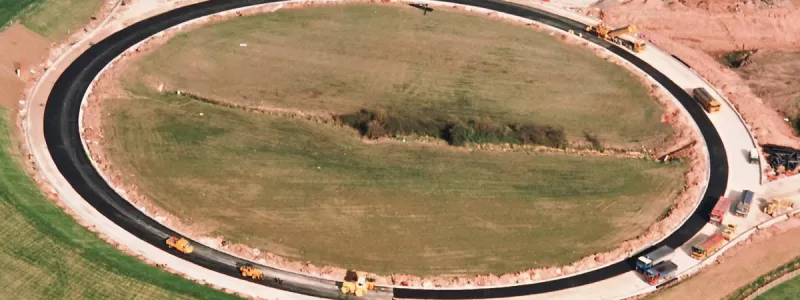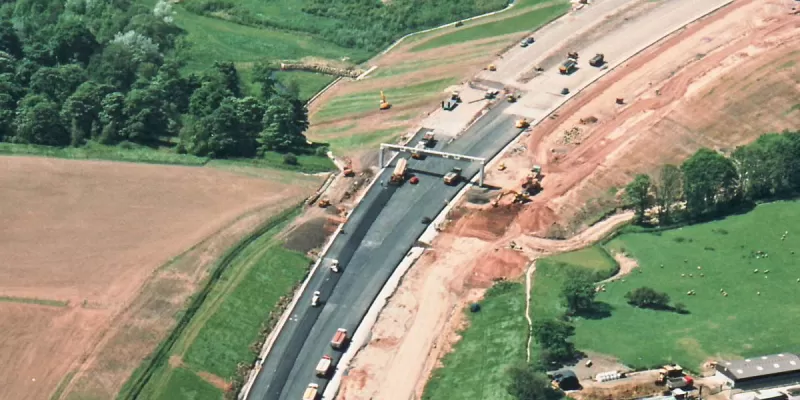There are 466 pictures in this set - even the most hardcore fan of the finer details of motorway construction would have to admit that's a lot. How do you know where to start?
Thankfully we've tried to make it a bit easier to get your head around them. The map view available from the main page lets you pick one of the 27 most frequently-photographed viewpoints, so you can easily see a single structure or section being built up over time. And on this page, we've gathered together some of our favourites that show something particularly interesting or unexpected.
Putting up a fight
The mid-1990s were the era of Twyford Down, the Newbury Bypass and "Swampy", so unsurprisingly the M65 project was the scene of spirited anti-roads protests too. By the time contract 1 was under way, protestors had moved into a treetop camp at Stanworth Valley, where a viaduct would later be built as part of contract 2. Their camp was close enough to the boundary to appear in one of the photographs from January 1995.
Three months later, one of the pictures from April 1995 captures an incredible scene: some ground clearance has just started on contract 2 at Stanworth, but the solitary earthmover on site is being mobbed. Surrounding it are police in hi-viz vests, and a convoy of white Land Rovers (from the construction company) and police vans are lined up on the track leading to the work site.
It can only be an environmental protest in action - presumably some of the residents of the treetop camp, visible in the background, who have chained themselves to the earthmover.
Heavy engineering
Building a motorway is a complex job and calls for a lot more work than just laying some tarmac. Some of the diverse range of engineering jobs on the project were captured in action.
Just south of M6 junction 29, an existing culvert that carries a stream under the M6 needed to be extended so that the embankment on top of it could be widened. To do that, the embankment had to be dug out to expose the existing structure, the water diverted out of the side and around the work site, and the concrete box structure then extended.
This picture, from July 1996, shows the whole process in one. The earthworks have been dug out, and water is now flowing out of a break in the side of the culvert and around a temporary course to the right. The existing culvert is being broken up by a jackhammer. Further along, steel reinforcement and formwork can be seen where concrete will be poured to form the new section of the culvert.
At Tramway Lane, the bridge carrying the M65 over the road had to be supported on deep-bored piles - long concrete columns pushed deep underground to find a stable support for the weight of the structure. In October 1995, a pile driver was on site to begin installing them.
On the left, a deep shaft has been sunk into the ground. The red pile driver has moved back, and a yellow mobile crane is now lowering a hollow steel core into it. Two workmen in red hard hats are peering down as it goes in. Behind the crane, a concrete mixer is on site, ready to pour the new pile.
It's not all building things, either. At the M65 interchange, a skew bridge carrying a minor local road was in the way of the new interchange. It was demolished in April 1996 - probably during a weekend closure of the M61 on Sunday 28 April, the day before this picture was taken.
Seen here are the remains of Brindle Road bridge. The middle part of its span has been cleared away, pehaps overnight, so that the M61 can be reopened to traffic; on the hard shoulder and down the embankments, though, are the forlorn remains of the concrete beams and bridge deck. These are now being broken up into rubble by an army of pneumatic hammers.
Spanning the void
Most of the bridge work involved building bridges rather than demolishing them. Most of the 466 photos include bridge structures in various states of construction, but here are two examples that clearly show work actually in progress.
The first, from July 1995, is at the eastern end of the viaduct carrying the M65 across the M61. This enormous structure took several years to build. Here, the piers (or vertical pillars) are complete, and steel spans are being lifted into place between them; the steelwork will eventually have concrete deck sections fitted between them.
Two enormous mobile cranes are on site, along with a stack of steel beams. The crane on the left is without a doubt there to install the next set of spans; the smaller one may be helping dismantle scaffolding around the newly-completed bridge piers.
A year later, and a bit further west at the M6 interchange, this picture from October 1996 shows the deck of the other long viaduct structure being formed.
The deck is formed by fitting pre-formed concrete blocks between the steel spans, and then a solid deck is laid across them. A layer of concrete is laid before the tarmac road surface. Here, concrete is being poured - fed from the concrete mixer on the left via a long pipeline craned up from the vehicle on the ground. On the viaduct, a crew of about ten workers are directing the concrete pour, spreading it and levelling it. Opening the full size picture reveals other parts of the viaduct deck in various states of completion, including whole missing sections above the M6.
Rolling out the black carpet
The various stages of construction for the road itself are also well-represented in the photos; virtually every picture will show you one stage or another of the process. These four are nice examples of the various steps.
The first step is, of course, to grade and level the road bed. In this picture from July 1995, earthmovers are on site at the terminal roundabout near Bamber Bridge. The ground level has been raised slightly and is now being levelled, a long and skilled process.
The road bed is then built up in layers, using graded loose material of various sizes and then by progressively laying courses of binding material. By October 1995, three months later, this picture shows that kerb lines and drainage had been installed and the road bed was receiving its first layer of black tarmac. At the top right, a surfacing train is part-way around its second pass of the junction.
The process of laying a surface involves the raw material mix being tipped onto the road from a moving tipper truck, and a specialised vehicle travelling immediately behind it that applies heat and which rolls it into place. This "train" is then followed by one or more rollers to level out the new surface while it's still hot and malleable. Usually, the surface is laid in the direction it will be travelled, and in long strips that match the lanes that will be marked on the road, so the joins are kept away from the most heavily-worn parts of the surface.
Just east of the M6 interchange, this process can be seen happening in a photo from June 1997, as a second layer of tarmac is applied on top of the first. Each tipper truck is emptied relatively quickly, so a queue of others can be seen waiting to take over at the bottom of the picture.
The final layer of tarmac is called the "wearing course" and this is the one traffic will travel upon. Once it's in place, road markings are added, and the road is complete. But the job may not be done, especially on a big project like the M65: once the road surface is down, it will continue to be used by works traffic travelling along the length of the site, covering it in a layer of either mud or dust, depending on the weather.
In this picture, also from June 1997, the road at Stanworth cutting has been finished for a little while, but is very dusty from the passage of works traffic and other work that has been happening, such as the installation of crash barriers. A road sweeper is cutting a line of clean black tarmac through the dirt. The whole road will be swept like this before opening, but to keep the job manageable, any finished sections are also swept fairly regularly even before that.
Job done
The final picture set, from December 1997, was taken after work had been finished and just a day or two before the new motorway opened to traffic. All the photos from that month show a pristine road, just completed, but here's our favourite: an almost overhead shot of the finished junction at the M6.


